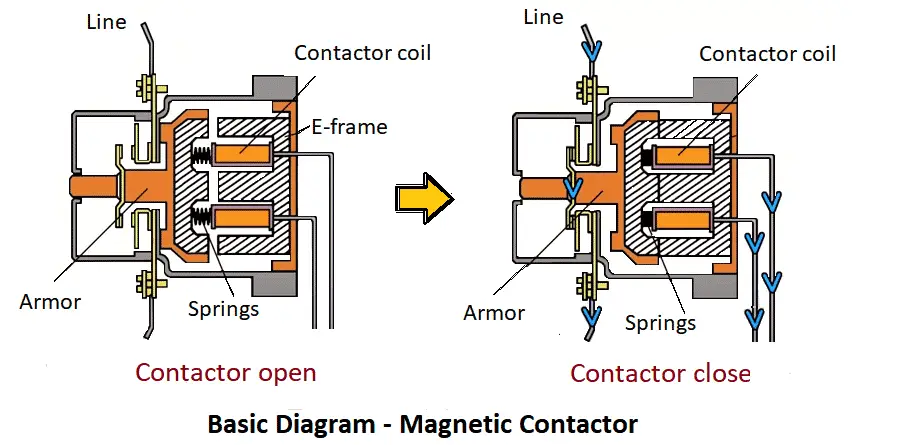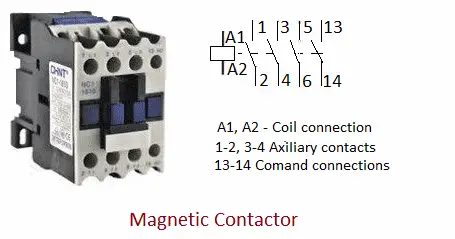The magnetic contactor is a switch operated or controlled remotely by an electromagnet. The magnetic contactor functions on the principle of electromagnetism.
Magnetic Contactor
It is an electromechanical device whose objective is to establish or interrupt the flow of current in the power or control circuits.
It is a device that can cut off the electrical current of a receiver or installation. When the magnetic contactor coil receives the supply from the remote, it has two operating positions. One position is at rest when it does not receive any action from the control circuit, and another position is unstable when this action occurs.

Magnetic Contactor Working Principle
A contactor driven by magnetic energy consists of a magnetic core (core and armature) and a coil that generates a magnetic field strong enough to overcome the forces of the springs that keep the two parts of the core apart. One of these parts, usually the armature, is integrally attached to the device and actuates the electrical contacts.
Electromagnet
The magnetic circuit comprises a (fixed) core, an armature (mobile), and the shadow loop, the latter required for electromagnets powered with alternating current. The magnetic circuit includes a small air gap in the “closed “position to prevent any remaining flux from holding the moving armature.
Core
The core is made of silicon steel sheets tightly bonded to reduce energy losses caused by the circulation of current parasites. Its function is to house the coil, concentrate its magnetic flux, and attract the armor.
The armature is the moving element of the electromagnet. It is very similar to the nucleus, but unlike it, it does not have turns of shade. Its main function is to close the magnetic circuit and drag it to mobile contacts.
Coil
The force of attraction of the electromagnet is a function of the magnetic flux that goes through. To originate this flux, an excitation coil is housed in one of the columns of the electromagnet core. The reels can be wound on a spool of insulating resin.
Enameled copper wire with a circular section is generally used for the construction of coils, and the procedures for their preparation are techniques well known.
The coil characteristics are indicated in a visible place on the coil: Voltage, class of current, and frequency in case of alternating current.

Types of Contacts
They are conductive elements that establish or interrupt the current flow when the coil is energized.
There are two types of contacts.
- Main Contacts
- Auxiliary contacts
1. Main contacts
The contacts that act directly on the load to be controlled are called the main contacts or poles.
The main contacts are connected to the circuit to be governed. Ensuring the establishment and interruption of the main currents and depending on the number of current paths, it may be bipolar, tri-polar, tetra polar, etc., maneuvers being carried out simultaneously on all tracks.
2. Auxiliary contacts
There are two types of auxiliary contacts.
- Normally Open (NO)
- Normally Closed (NC)
These two types of contacts form part of the auxiliary circuit of the contactor. It ensures the self-supply, controls, contact interlocks, and signaling in the automation equipment.
When the contactor coil is excited by the current flow, causing its core to move and drag its main and auxiliary contacts, it establishes the circuit between the network and the receiver.
Advantages of Magnetic Contactor
The contractors have advantages in terms of the following aspects.
- The possibility of completely controlling a machine from various control points or stations.
- Circuits subjected to currents can be controlled at very high.
- Safety for technical personnel.
- Given that the maneuvers are carried out from places far from the motor or other types of loads.
- The currents and voltages manipulated with the command devices are or may be small.
- Control and automation of equipment and machines with complex processes.
Types of Magnetic Contactors
There are two types of magnetic contactors.
- AC Contactor
- DC contactor
Categories of Alternating Current (AC) contactors
AC-1 Magnetic Contactor
This category applies to all AC loads with a power factor of at least 0.95. These are mainly non-inductive or slightly inductive loads. Interruption is easy.
AC-2 Magnetic Contactor
This category applies to wound rotor induction motors.
AC-3 Magnetic Contactor
This category applies to squirrel cage induction motors, where the disconnection occurs while the motor runs at full speed. The breaking current is nominal.
AC-4 Magnetic contactor
This is applied for starting and stopping a cage induction motor. Squirrel- stop during start, jogging, and reversing by reverse.
Categories for DC contactors
DC-1 Magnetic Contactor
This applies to all DC loads, mainly non-inductive or slightly inductive ones.
DC-2 Magnetic Contactor
This category applies to DC Shunt motors, where the disconnection occurs while the motor runs at full speed.
DC-3 Magnetic Contactor
It is applied for starting and stopping DC shunt motors, stopping during starting, jogging, reversing by reverse gear, and dynamic braking.
Precautions
Under normal conditions, contactors will not fail if they are selected correctly for a particular application and used correctly. Contact wear and coil burn are the two most common problems.
However, over-current flowing through the magnetic contactors causes the primary contacts to stick. A magnetic contactor requires protection devices such as overload relays and fuses for improved system protection.